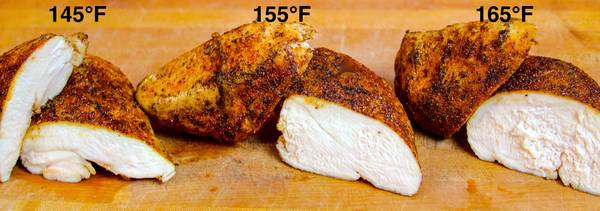Ensure moist and tender boneless chicken breasts on the grill every time with the ultimate guide to the sous-vide-que cooking method. Read on for our sous vide chicken recipe.
I am not a breast man.
And by not being a breast man, I am, of course, referring to the original white meat – chicken.
I appreciate the cut for its meatiness and overall flavor. But it’s hard to forget the hundreds of stringy, dry as a bone breasts I have suffered through.
Problems with cooking chicken breast
Why is it so difficult to properly cook a chicken breast? The problem is two-fold. First, unlike a fattier thigh that is almost impossible to overcook, breast meat is very lean and prone to dryness. Second, UDSA tells us to cook chicken to at least 165°F in order to kill harmful pathogens. And for many years they said 170 to 175°F! With normal grilling, we are quite comfortable that 160°F is safe. Cooking to such a high temperature will, indeed, take care of any existing salmonella bacteria. But it will also guarantee a significantly less tender and juicy breast versus one cooked to a lower internal temperature.
So what’s a backyard griller supposed to do? Enter the Sous-Vide-Que method (read more about it here). By preparing the chicken breast in a controlled temperature water bath before finishing on the grill, we are able to extend the cooking time and therefore reduce the temperature needed for pasteurization. Instead of literally cooking bacteria to death at 165°F (and drying the breast out in the process), chicken can now be safely sous vide at temperatures as low as 136°F if cooked for at least one hour and then finished on the smoker and/or grill to crisp the skin, brown the surface, and get the wonderful flavors from the Maillard reaction and the grill.
Finding the Perfect Sous Vide Temperature
Tired of overcooked chicken, I set out to determine the perfect sous vide temperature for the creation of the ultimate moist and tender sous vide chicken recipe. For the test recipe, I used three boneless, skinless chicken breasts, all roughly the same weight, shape, and size.
Each breast was brushed with olive oil then liberally seasoned with McCormick Applewood Rub before sealing in separate freezer bags. The breasts were then cooked for 2.5 hours in water baths set to the following temperatures. 145°F for breast number one, 155°F for breast number two, and 165°F (the USDA minimum temperature) for breast number three. Note that the breasts could be safely sous vide as low as 136°F. But we started at 145°F as chicken cooked at lower temperatures can be too soft and smooth for most.
After the controlled water bath was over, the breasts were removed from their bags. Then they were grilled over direct heat for approximately two minutes per side for a nice color and grill flavor.
Explore the world of Sous Vide Que, the ultimate marriage of water and smoke, by clicking here to download our ebook “Sous Vide Que Made Easy” for $3.99 on Amazon (free Kindle app runs on all computers). Or get the book and others FREE as a member of the AmazingRibs.com Pitmaster Club. Click here to join.
The Results
Upon completion of the grilling the breasts were sliced and compared side by side. As expected, the breast cooked at 165°F was the least juicy and tender of the three. It had very well defined muscle fibers and a slightly mealy texture. On the opposite end of the spectrum, the 145°F breast was so moist and tender that it was almost too soft for my personal taste. In between was the breast prepared at 155°F, featuring just enough texture and the right amount of moistness and tenderness to keep me coming back for more.
Even more interesting, though, was the overall look of the breasts following their controlled temperature water bath. As is apparent from the side-by-side photo, the breasts actually became plumper as the temperature went up as the muscle fibers shrank as the heat increases.
In the end, I am hesitant to declare the breast prepared at 155°F as the hands down winner as I do believe that many people would find the 145°F breast to be spot on. So I recommend splitting the difference and settling on 2.5 hours at 150°F which is just slightly higher than our temperature suggestions in our sous vide que guide here.



High quality websites are expensive to run. If you help us, we’ll pay you back bigtime with an ad-free experience and a lot of freebies!
Millions come to AmazingRibs.com every month for high quality tested recipes, tips on technique, science, mythbusting, product reviews, and inspiration. But it is expensive to run a website with more than 2,000 pages and we don’t have a big corporate partner to subsidize us.
Our most important source of sustenance is people who join our Pitmaster Club. But please don’t think of it as a donation. Members get MANY great benefits. We block all third-party ads, we give members free ebooks, magazines, interviews, webinars, more recipes, a monthly sweepstakes with prizes worth up to $2,000, discounts on products, and best of all a community of like-minded cooks free of flame wars. Click below to see all the benefits, take a free 30 day trial, and help keep this site alive.
Post comments and questions below
1) Please try the search box at the top of every page before you ask for help.
2) Try to post your question to the appropriate page.
3) Tell us everything we need to know to help such as the type of cooker and thermometer. Dial thermometers are often off by as much as 50°F so if you are not using a good digital thermometer we probably can’t help you with time and temp questions. Please read this article about thermometers.
4) If you are a member of the Pitmaster Club, your comments login is probably different.
5) Posts with links in them may not appear immediately.
Moderators